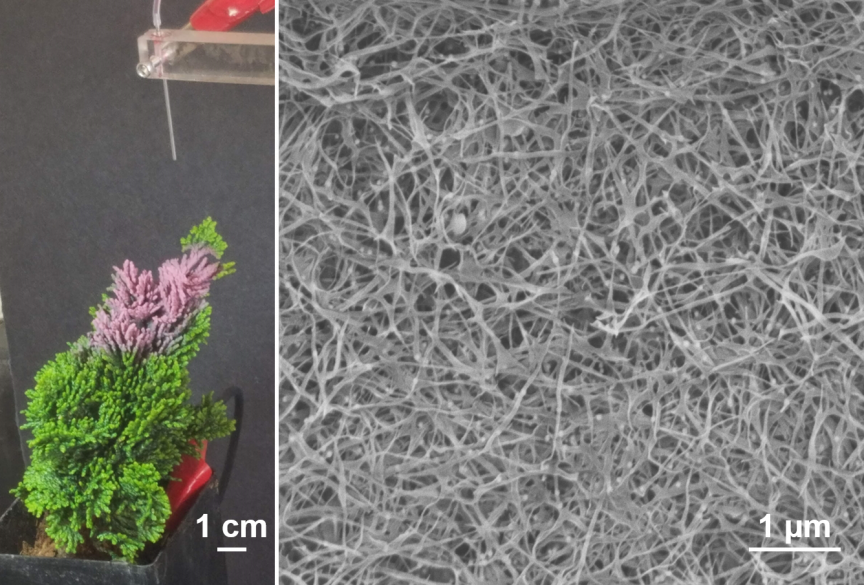Oct 8 2020
Engineers have developed a new method to spray very thin wires produced from a plant-based material. This method could be applied to devices that harvest energy to generate electricity, N95 mask filters, and perhaps for creating human organs.
 Photo (left) of a nanowire forest being sprayed on a miniature tree, with color (purple) arising from embedded gold nanoparticles. Electron microscope image (right) of the nanowire/nanoparticle blend. Image Credit: (left) Jonathan P. Singer; (right) Lin Lei.
Photo (left) of a nanowire forest being sprayed on a miniature tree, with color (purple) arising from embedded gold nanoparticles. Electron microscope image (right) of the nanowire/nanoparticle blend. Image Credit: (left) Jonathan P. Singer; (right) Lin Lei.
According to a study headed by Rutgers University and published in the Materials Horizons journal, methylcellulose—a renewable plastic material extracted from plant cellulose—is used in this method. The material is sprayed on 3D-printed and other objects, spanning from plants to electronics.
This could be the first step towards 3D manufacturing of organs with the same kinds of amazing properties as those seen in nature. In the nearer term, N95 masks are in demand as personal protective equipment during the COVID-19 pandemic, and our spray method could add another level of capture to make filters more effective. Electronics like LEDs and energy harvesters also could similarly benefit.
Jonathan P. Singer, Study Senior Author and Assistant Professor, Department of Mechanical and Aerospace Engineering, School of Engineering, Rutgers University
Nanowires or thin wires made of soft matter find several applications, such as the setae (bristly structures) that enable geckos to grip walls, and the cilia that keep the humans’ lungs clean. These wires have also been utilized in tiny triboelectric energy harvesters, with upcoming examples probably including a door handle sensor that turns on an alarm, or strips laminated on shoes to charge a cellular phone.
Although people already know how to produce nanowires right from the introduction of cotton candy melt spinners, regulating the procedure has always been quite limited. The obstacle has been the inability to spray rather than spinning these wires.
Singer’s Nanomanufacturing or Hybrid Micro Laboratory, in association with engineers from Binghamton University, demonstrated the fundamental physics to produce such sprays. With the help of methylcellulose, the team has produced “forests” and foams of nanowires that could be applied to 3D objects. In addition, they showed that gold nanoparticles could be integrated into wires for coloration and optical sensing.
The study’s lead author is Lin Lei, a doctoral student from Rutgers University. Catherine J. Nachtigal, an undergraduate student from Rutgers University, also contributed to the research work.
Journal Reference:
Lei, L., et al. (2020) Homogeneous gelation leads to nanowire forests in the transition between electrospray and electrospinning. Materials Horizons. doi.org/10.1039/D0MH00872A.